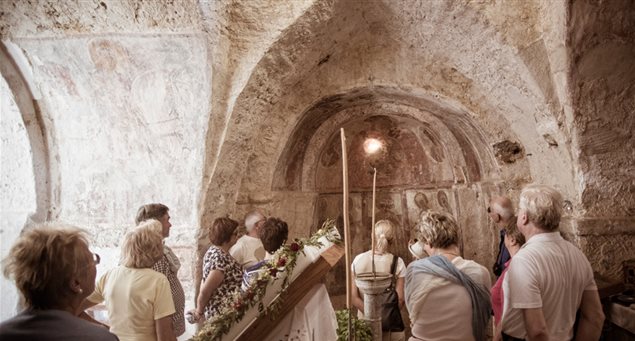Photo: On Holy Friday, midday, at the church of Panagia Drossiani, the women share a special Lenten raisin-walnut bread with parishioners.
One of the key characteristics of Naxos as a destination is its many, well-populated villages.
Adopting some elements of modern lifestyle and maintaining many aspects of their old world charm, these villages are steadfast in keeping their rich traditions and customs alive.
This is especially true during the holidays, and, more specifically, during the Greek Orthodox Easter (this year on April 20th).
On Naxos, just like in most parts of Greece, Easter ushers in the beginning of Spring.
During this time, many Greeks travel to mountain and seaside villages to celebrate the rich spiritual, religious and cultural traditions associated with the holiday: attending mass, partaking in the procession of the Epitaph on Holy Friday; the breaking of red eggs on the eve of Easter Sunday; and enjoying the traditional meal of Easter Sunday.
In the villages of Naxos, there are additional unique customs that are associated with the Easter holiday.
Here are a few:
The Swings at Komiaki
A tradition that began long ago, and expected to be revived this year, is the delightful and “flirtatious” tradition of the swings.
The day after Easter Sunday, in the village of Komiaki, where many of the streets feature wood-ceiled arches, the locals find sturdy beams of in which to hang a makeshift swing. The swings are set up for the young girls of the village, who as they swing, are serenaded by young boys reciting improvised poems.
[Komiaki, also known as Koronida, is located in northern Naxos and about 35km from Chora.]
The Walnut Raisin Bread at Moni
In the old days, homemakers would bake bread for the coming week on Saturdays.
This tradition led to the baking of a special raisin-walnut bread on the Saturday of Lazarus, the Saturday before Holy Saturday (and the day before Palm Sunday). In the village of Moni, homemakers and women tending to the church would bake this bread in the shape and form of a person or a baguette, known as “Lazarakia” or poulos, to be consumed on Holy Friday, a day of strict fasting. Today, this custom continues with the bread being baked by the village bakery, but on Holy Thursday.
On Holy Friday, midday, at the church of Panagia Drossiani, the women share the raisin-walnut bread with parishioners.
[The Church of Panagia (Virgin Mary) Drossiani, one of Naxos’s oldest churches, is located a short distance from the village of Moni (about 20 minutes and 20 km from Chora).]
The Road of Lit Reeds at Eggares
On Holy Friday, in the village of Eggares, the route of the Epitaph is lined stalks of reed (known as kalamia) that have been lit by the young boys of the village resulting in a solemn, powerful image.
[The village of Eggares, is approx. 9km and a few minutes from Chora.]
Village Variations of the Traditional Easter Plate Batoudo
The traditional dish of stuffed baby goat and potatoes, known as batoudo, on Naxos, has a couple of variations based on what village you visit.
In Apiranthos, for example, the basic stuffing, of herbs, onions and rice, is enriched with raisins while in in Filoti, bits of liver are added.
The egg that “opens and closes the mouth” and the Lenten season
The eve of the resurrection parishioners bring along their red Easter eggs and after the liturgy crack them and consume them signalling the end of the fast and the beginning of “eating.”
Similarly, signaling the start of Lent, the Sunday before Shrove Monday, believers eat an egg (the last non-Lenten food) symbolizing the “closure” of the mouth and the beginning of the fast.


